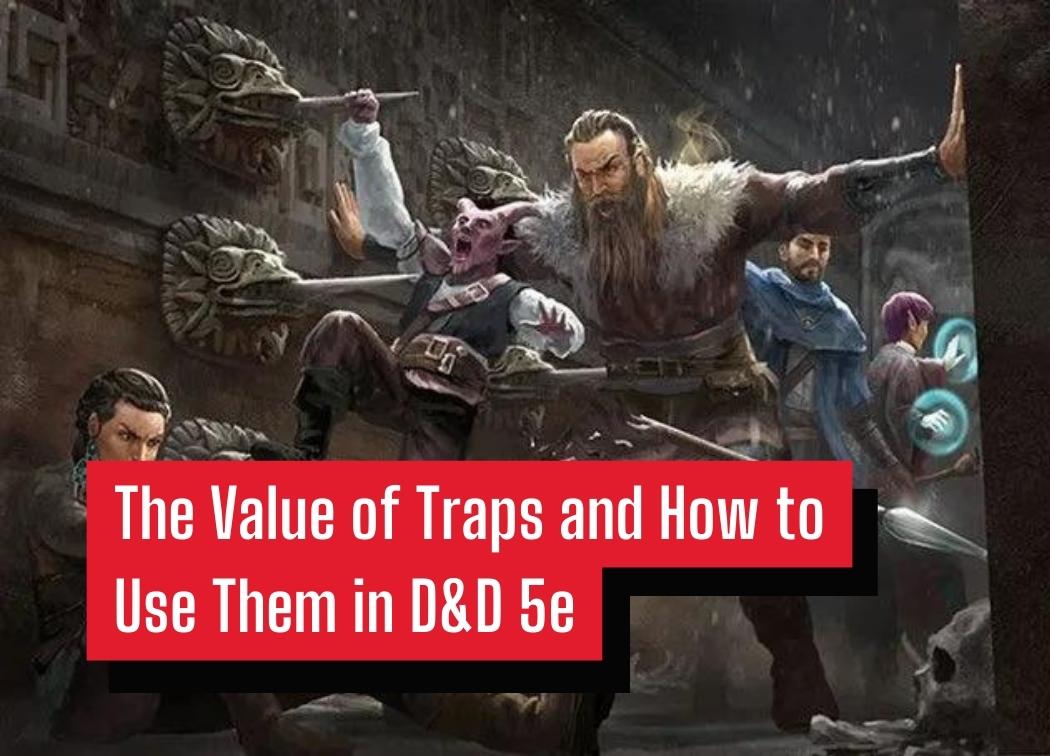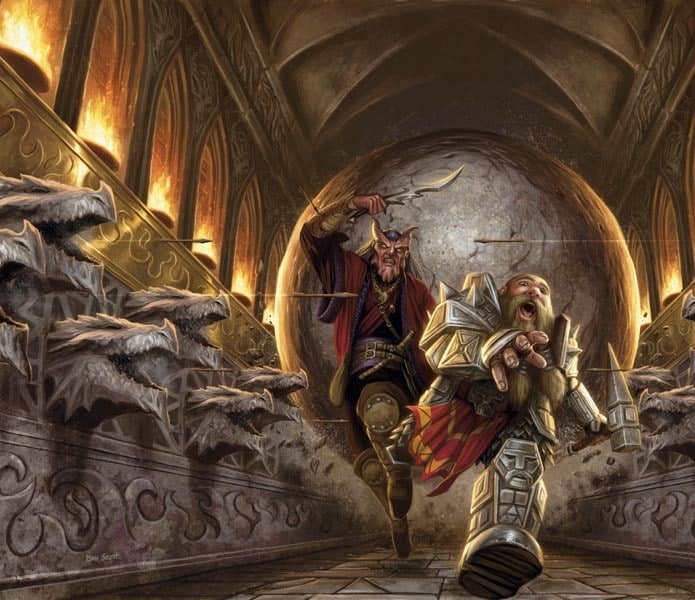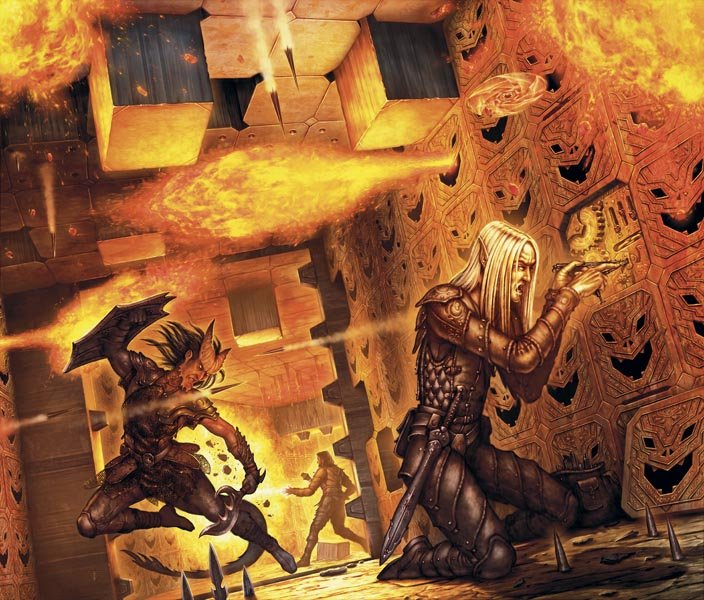The Value of Traps and How to Use Them in D&D 5e

Hi all! Today’s awesome guest article was written by Applefritter (reach them via E-mail here). They play a wide variety of RPGs including The Burning Wheel, Call of Cthulu, and D&D 5e. Applefritter has a love for writing and creating content for D&D 5e in particular.
I’m sure it’s happened to everyone who’s played D&D seriously. You fail your Dex save or don’t notice the tripwire at your feet. But traps are special for the DM, as well as presenting a challenge for the players. And then we get to the classification of traps as obstacles.
How do you make a balanced trap- most likely you’re going to want to homebrew some traps. What’s the XP value for overcoming it? Why? What happens if the trap manages to kill or KO a player or players? It’s all quite confusing, so I hope this article will clear it up a bit.

The Value of Traps Compared to Monsters
Monsters or hostile NPCs are pretty clear, as far as a challenge goes. You have to somehow defeat them or neutralize the threat they pose. Traps are harder to deal with. You can never really tell what a trap is in advance, even if you find a trap. If you see a minotaur charging at you, you know it wants to fight you. But if you find a wire in an otherwise empty room, you don’t have any solid idea of what the trap could be. Of course, you’ll have some ideas but they won’t be assured.
This brings in doubt, which can cripple decision-making and make even a superficially trap seem deadly. Because it’s best to assume the worst out of everything you encounter in a dungeon (the leading cause of why old men with quests are killed), traps that do very little may slow down a player party considerably, giving more time for the dungeon’s inhabitants (assuming it still has them) to regroup and attack.
The Value of Monsters Compared to Traps
Even though they are obvious, monsters can still pose a challenge. The fact that you know the minotaur wants to kill you doesn’t change the fact that it’s charging at you and trying to kill you. Monsters also have an air of mystery to them because the player can’t see the stat block of it.
This effect is, however, diminished not only because players may fight multiple monsters of the same kind at the same time, or use schema (and/or class features) to learn things about it. But monsters have the advantage of being (usually) durable.
Because PCs are cautious to a fault around traps if they avoid the trap that’s usually it. Since monsters are more often sentient than not and traps will most likely not be, they can regroup and attack. Jumping over a tripwire means it no longer poses a threat- that’s some easy XP for almost nothing. But dodging the minotaur in our examples doesn’t mean you thwarted it, it just means it might hit you next turn.
The Value of Using Monsters and Traps in Concert
While traps keep the players guessing and monsters keep players on the defensive, their best use is together. A dungeon with traps has or had sentient creators once, for sure. Even dumb creatures, like goblins, can create traps.
A great example of monsters and traps combined is the mighty kobold. Although even a first-level character can one-hit a regular kobold, they can be worthy foes for two reasons. 1), they gang up on you. 1.5), they’re so DARN cute. And 2), they use traps ingeniously.
Let’s say you’ve been asked to clear out a kobold lair. Ok, nice. The townsfolk have even cast some reduce spells on you (or you’re all gnomes because halflings don’t have darkvision). You can go in without squeezing (a problem in itself). But kobolds only weigh about 15 pounds. The lightest gnome or halfling will weigh about 30 pounds or so. So what do you do?
The answer is obvious: design all the traps to trigger when something over 20-ish pounds walks over it. This is probably the best example in 5e of sentient monsters using traps to effectively double or triple their challenge rating.
Kobolds might be annoying in large mobs (like zombies) but their small size, measly hit points, and low-damage attacks most likely won’t give you a TPK, even at a lower level (unless you homebrew kobolds with levels in Rogue, which would make them super-OP and even cuter).
Kobolds have a challenge rating of ⅛, which means a mob of angry commoners could wipe out a few. But follow them into your lair, and you’re in for a world of hurt, as you step on a twig that alerts all kobolds in the complex that you’re here, and also flings some rusty forks covered in Alchemist’s Fire at your face.
That trap would hurt but not kill by itself. Kobolds would hurt but not kill by themselves. But kobolds with traps just might down a player (although given how rarely character death happens in 5e…).
Utilizing Traps
So we know that traps are good, and we know that traps with monsters are great. But how do you use them? To answer this question we’ll look at one of my favorite adventures in 5e- Tomb of Annihilation.
The tomb is a great dungeon because it’s chock-full of both monsters and traps- as icing on the cake, it even has a reason for why the traps have been functioning and will continue to function for the rest of time if not interfered with.
For those who don’t know, the basic story of Tomb goes like this: you’re a bunch of first level characters wandering around randomly, and suddenly there’s a curse on people who’ve been resurrected making them lose 1 point of their hit point maximum every day. Yes, you have to keep track of time on this adventure.
The source is somewhere in the jungled wilderness of Chult, which also has, like, a lot of zombies. Much zombies. Very bite.
So now your band of adventurers has to advance 14 levels and eventually beat both a baby god of entropy and death after grinding through a 6-level dungeon with a bunch of skeletons that have fancy heads (boss keys) so you have to go through the ENTIRE DUNGEON.
Theoretically, you can avoid a miniboss fight with a Yuan-Ti called Ras Nsi who steals your boss key to the boss keys, but that means your archmage friendo who teleported you to Chult dies as well, and a LOT of other people. But who cares because it means you don’t have to fight a serpent dude with a magic item and a lot of shields, even though he only has 2 arms!
Whatever. That doesn’t matter. But the Tomb is full of traps that not only balance with the monsters but can be reused and with an explanation for the power source on some of the larger traps.
A cool thing about the undead is that they won’t die of natural causes- a dungeon run by undead will run forever if they undead running it are 1), sentient, 2), have a list of complex commands left behind that help run the dungeon, or 3), have a controller or greater creature with the ability to control or command undead.
In this case, Acererak the Arch-lich (the main villain) likes building sprawling dungeons to lure in adventurers, which is linked to his phylactery. So any adventurer that dies goes to sustaining Acererak’s phylactery. It’s like Kickstarter but the money is souls. The traps are maintained by dead dwarves that Acererak raised as Wights, which are indeed sentient. So even if Acererak isn’t here, the dungeon will still be maintained.
But, you ask- how to power the traps? It would be inefficient to keep them mechanically powered because adventurers aren’t going to be in the dungeon much- it’s through an entire jungle full of ravenous undead into a city full of danger with puzzle cubes in dangerous shrines that you have to align, not to mention an entire temple of Yuan-ti.
The undead aren’t generally known to be good spellcasters unless they’re liches, and there isn’t an abundance of powerful spellcasters who want to be liches in any case. So what do you do?
Using tech over magic
Sure. A good way to solve this problem would be to have magic powering the dungeon- it’s ancient, it’s cool, and it doesn’t have to fit by the rules. But it’s kind of unsatisfying to just say “oh, the traps are powered by MAGIC!” it’s cooler to have something like the Tomb’s power source- a Mechanus Chain.
Basically, it’s a massive chain that is rotating constantly in a planar rift, drawing energy from everywhere in the multiverse. They literally power Mechanus (I don’t know how Acererak managed to steal one but…) and take 3 wish spells to destroy. Basically, you won’t destroy them. But it fits. The tomb dwarves fulfill our criteria for dungeon maintenance, and the Mechanus chain provides a satisfying power source. This sounds like a pretty good dungeon design.

Complex Traps
An interesting part of Xanathar’s Guide to Everything is the section on complex traps. In general, it’s the first book I’d recommend getting (players and DMs alike) after the core set, because of the multitude of rules for both players and DMs.
One of the new DM rule options is the section on complex traps. These traps are more than just a pit in the ground laid by goblins- take the example they give you. When you enter a hallway and you’re not undead, the trap activates.
The door you’re trying to get to is 150 feet (ish) away. The first 50 feet are whirling blades. You can make a Dex check to dodge them, or an Intelligence check to determine the pattern. The next 50 feet are crushing columns coming out of the ceiling. The last 50 feet have fear glyphs on the walls which send you running back through the pillars and the blades.
Okay, so that’s a lot of things, but effectively it’s just 3 traps in a row that are especially hard to avoid. Not so- you see, complex traps have an initiative! On its’ initiative (which is not rolled for- it activates on 10, 15, 20, and/or multiple times during the round) the trap does varying things.
Let’s go back to the example of the hallway from Xanathar. The blades get faster every time they miss, which is a passive effect. The pillars crush down on another initiative. The runes of fear pulse on initiative.
The blades don’t do anything on initiative, but they have a passive effect- when someone is missed, the blades do more damage the next time they hit. This makes dodging harder because eventually, you’re going to get hit. You get paid back with interest, essentially, unless you never get hit at all.
Conclusion
Traps are a powerful weapon in the arsenal of the DM to thwart, confuse, and down players. And no one says traps have to kill you- quite the opposite! It’s going to be super annoying to be right at the boss fight, then step on the wrong tile and be teleported to the top.
Traps can split the party, letting the monsters in the dungeon (most likely maintaining the traps) kill them off one by one. Not that you can’t use traps or monsters by themselves, certainly.
But, like in Magic: The Gathering, your dungeon is going to be a lot stronger if you’re mixing two things together. Or using a 1 cost 10/10 in a deck with only tutor spells. Either one of those, really.
